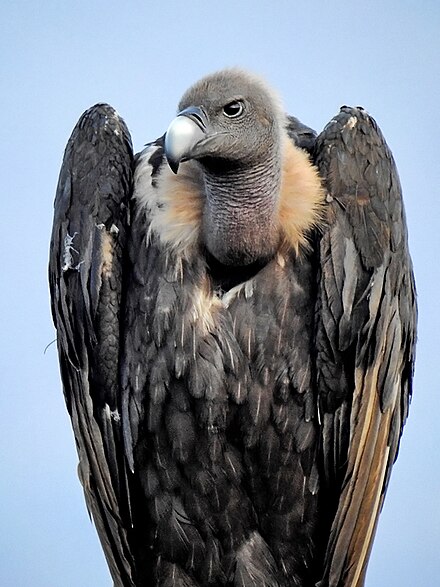
White-Rumped Vulture
 The white-rumped vulture is an Old World vulture native to South and Southeast Asia. It has been listed as Critically Endangered on the IUCN Red List since 2000, as the population severely declined. White-rumped vultures die of kidney failure caused by diclofenac poisoning. In the 1980s, the global population was estimated at several million individuals, and it was thought to be “the most abundant large bird of prey in the world”. As of 2021, the global population was estimated at less than 6,000 mature individuals. It is a close relative of the European Griffin vulture and was first described in 1788.
The white-rumped vulture is an Old World vulture native to South and Southeast Asia. It has been listed as Critically Endangered on the IUCN Red List since 2000, as the population severely declined. White-rumped vultures die of kidney failure caused by diclofenac poisoning. In the 1980s, the global population was estimated at several million individuals, and it was thought to be “the most abundant large bird of prey in the world”. As of 2021, the global population was estimated at less than 6,000 mature individuals. It is a close relative of the European Griffin vulture and was first described in 1788.
Now, the population dropped 99% over just 3 generations, prior to 2000 (in around 10 years). It has remained relatively stable since, however, quite rightly, while the population has ceased to fall, it has not recovered significantly in the last 20 years.
It is the smallest of the Gyps vultures, but is still a very large bird, weighing 3.5–7.5 kg and measuring 75–93 cm in length, and has a wingspan of 1.92–2.6 m.
This vulture builds its nest in tall trees generally near human habitations in northern and central India, Pakistan, Nepal, Bangladesh and southeast Asia, laying one egg (making it impossible for the population bounce back particularly fast. Birds form roost colonies. The population is mostly resident.
It was (at one time) the most numerous vulture in India. They are also a communal nester, often with multiple nests in the same tree. It has suffered a 99% reduction in numbers since the 1990s . Recovery must be worked on (there are many people working on this)










